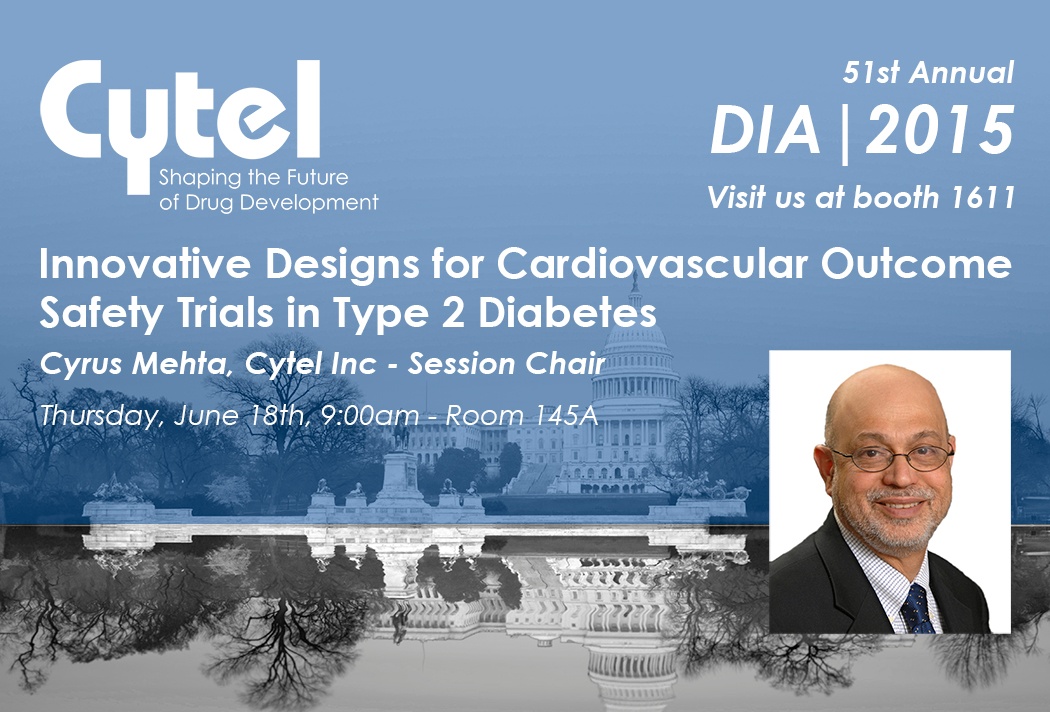Aligning Clinical Development & Regulatory Objectives for Cardiovascular Outcome Trials

When the FDA first began to require pharmaceuticals to perform cardiovascular outcome trials to establish the safety of certain new drugs, many worried that this new regulatory requirement would diminish investments in therapeutic areas like diabetes and obesity [1]. CVOTs are typically designed as massive time-to-event trials that need to enroll several thousands of patients to establish safety [2][3]. The sheer number of patients and size of the trial increases the time that it takes for these drugs to get to market.
So what is it the makes US and EU regulatory strategy different for diabetes and weightloss drugs, and how should this effect clinical development strategy?
Next week’s DIA 2015 will witness a panel, chaired by Cytel President and co-founder Cyrus Mehta, which will bring together industry leaders from the United States and Europe who are also members of the Cardiac Safety Research Consortium. The panel will discuss regulatory and clinical development strategies for conducting CVOTs. The FDA’s Aloka Chakravarty will also be a panelist.
What do US and EU Regulations Require from a Cardiovascular Outcome Safety Trial?
FDA requires that when comparing the incidence of adverse cardiac events in the active and placebo arms of a trial, (events like death, myocardial infarction and nonfatal stroke,) a sponsor must be able to demonstrate that the upper bound of the 2-sided 95% confidence interval for the estimated risk ratio is less than 1.8 [5]. The EMA guidance, by contrast, does not provide a specific threshold of ‘excess risk.’ Rather, safety is evaluated based on the overall quality of the findings. [5]
Both FDA and EMA require an independent (blinded) endpoint selection committee to adjudicate proper endpoints prior to the start of a safety study. [5]
Clinical Development Strategies for Cardiovascular Outcome Trials
An array of new clinical development strategies have emerged for shortening the time it takes to complete a cardiovascular safety study. One strategy includes introducing additional endpoints to increase the number of events observed, a strategy which shortened one CVOT by two years [2]. Another involves using a promising zone to determine sample size only after an interim look [2].
As clinical trial design strategies proliferate, determining what sorts of trial designs will align the objectives of a sponsor with those of regulators might seem overwhelming. A recent paper by members of the Cardiac Safety Research Consortium outlines six general approaches to CVOT trial designs [5] . These include:
- Meta-analysis of adverse cardiac events in Phase 2 and Phase 3
- A typical (post-phase 3) cardiovascular outcome trial
- Meta-analysis combined with a CVOT
- A combined trial for cardiac safety and glycemic efficacy (i.e. for anti-diabetic medication)
- Adaptive clinical trials which allow for early stopping, sample size re-estimation, etc.
- A group sequential design
The Importance of Enrichment
The Cardiac Safety Research Consortium also points out that enriching a trial with subpopulations known to have higher cardiovascular risk is not only beneficial for clinical development (i.e. to increase observed events), but also necessitated by the FDA guidance. Populations at higher cardiovascular risk include those who have had Type II diabetes for several years, older populations, and those with chronic kidney disease. [5]
The DIA Session [6]
The 51st Annual DIA Conference will be featuring a panel on CVOT strategies for Type II diabetes drugs. Panelists include three members of the Cardiac Safety Research Consortium and a representative from the FDA. Click below to learn more:
Speakers:
Clinical Development Approaches and Statistical Considerations to Assess the CV Safety of New Type 2 Diabetes Therapies
Mary Jane Geiger
Senior Director, Cardiovascular & Metabolism Therapeutics
Regeneron Pharmaceuticals, Inc., United States
Meta-Analysis Approach to Establish Cardiovascular Safety: Experiences and New Suggestions
Stefan Hantel, PhD
Principal Statistician
Boehringer Ingelheim Pharma Gmbh & Co. KG, Germany
Adaptive Designs to Demonstrate Risk Reduction in Cardiovascular Outcome Trials
Cyrus R. Mehta, PhD
Founder and President
Cytel Inc., United States
Panelist
Aloka Chakravarty
Director, Division of Biometrics VII, Office of Biostatistics, OTS, CDER
FDA, United States

